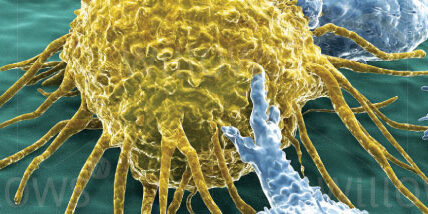What is Cancer?
Cancer is as common in our pets as it is in humans, occurring in one third of all patients. The body is made up of billions of cells arranged in a very complex manner, for which there are certain ‘behaviours’ and ‘rules’ that all cells must follow. These rules control the rate at which the cells grow, age and die and the extent to which they stay in one place.
Cancer is caused when cells stop obeying these rules. They may grow too fast or fail to get old and die at the right time. They may also lose respect for the cells next to them invading into neighbouring tissue, and they may also move throughout the body and start growing elsewhere. The cells may also produce chemical substances that make the patient feel ill and have effects on other parts of the body, such as the immune system that helps to fight off disease.
What Causes Cancer?
Cancer is a genetic disease, abnormalities in the DNA will lead to the abnormalities in cell behaviour. Since many abnormalities are necessary before cancer will develop, cancer does not have a single cause. While some causes of these acquired genetic abnormalities and cancer are known (e.g. certain viruses, chemical substances, ultraviolet light, radiation) in most cases the cause of cancer is not known.
Is Cancer One Disease?
Tumours may arise from any one of many cells, tissues or organs in the body, and may behave in a benign or malignant fashion. As such, cancer is not one disease with a single treatment. Identification of the particular tumour type and its effect on the patient are important steps before deciding on the most appropriate treatment.
What are the Signs that my Pet may have Cancer?
There are various signs that an animal might show if he/she has developed cancer. The presence of any of these signs does not automatically mean that an animal has cancer as they could be caused by other conditions. Identification of any of these abnormalities should however prompt an investigation of the cause.
Potential clinical signs include:
- Abnormal swelling or mass
- A wound that won’t heal
- Loss of weight (particularly if the appetite is maintained)
- Loss of appetite
- Difficulty eating or swallowing
- Lethargy and lack of interest in exercise or playing
- Difficulty breathing
- Difficulty passing urine or faeces
- Bleeding or discharge from anybody orifice, e.g. mouth, rectum, vulva
- Offensive odour
- Unusual and persistent lameness or stiffness.
How is Cancer Diagnosed?
Diagnosis involves assessment of the abnormal cells in the primary tumour site, often a mass (lump), following a biopsy sample. Biopsy samples may also be taken from nearby lymph nodes. X-rays or a CT scan and ultrasound may be used to detect evidence of tumour spread elsewhere within the body. Blood tests may be taken to assess the patient’s general health and fitness for treatment, to look for other diseases, or, in some cases make a diagnosis of cancer.

Treatment for Cancer
The three main treatments for cancer are:
- Surgery: The surgical removal of the tumour cells
- Radiotherapy: The use of a strong X-ray beam to destroy cancer cells
- Chemotherapy: The use of anti-cancer drugs to kill cancer cells wherever they are in the body.
The most appropriate treatment will depend on the nature, location and extent of the tumour, the overall health of the patient and the owner’s wishes and expectation. There may be more than one way to treat any particular tumour and it is important that the treatment is tailored to the patient.
What Should I do if I Think my Pet has Cancer and What is the Outlook for Pets with Cancer?
As with all signs of ill-health, veterinary advice should be sought from your local Vet in the first instance. Depending on the nature of the problem, your Vet may discuss referral to a Specialist in Oncology.
Many animals with cancer can be treated successfully and some can be cured of their disease. It is uncommon for us not be able to help and improve the quality of life of a pet with cancer in some way.
To save this page as a PDF, click the button and make sure “Save as PDF” is selected.
Cancer Care
Find out more
To assist owners in understanding more about Cancer Care we have put together a range of information sheets to talk you through the some of the more common conditions seen and treated by our Specialists.

